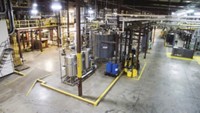Advertisement
Grab your lab coat. Let's get started
Welcome!
Welcome!
Create an account below to get 6 C&EN articles per month, receive newsletters and more - all free.
It seems this is your first time logging in online. Please enter the following information to continue.
As an ACS member you automatically get access to this site. All we need is few more details to create your reading experience.
Not you? Sign in with a different account.
Not you? Sign in with a different account.
ERROR 1
ERROR 1
ERROR 2
ERROR 2
ERROR 2
ERROR 2
ERROR 2
Password and Confirm password must match.
If you have an ACS member number, please enter it here so we can link this account to your membership. (optional)
ERROR 2
ACS values your privacy. By submitting your information, you are gaining access to C&EN and subscribing to our weekly newsletter. We use the information you provide to make your reading experience better, and we will never sell your data to third party members.
Environment
HCL Cleantech Wins Venture Funding
Israeli start-up touts process for using hydrochloric acid to make cheap sugar from cellulose
by Melody Voith
June 1, 2009
Biofuels start-up HCL Cleantech has received a first infusion of venture capital funding from Burrill & Co. and Khosla Ventures, two big names in clean energy investing. HCL, based in Tel-Aviv, Israel, has revived a World War II-era process for converting cellulosic feedstocks to sugar, a potential biofuel feedstock, using concentrated hydrochloric acid.
HCL Cleantech was founded in December 2007 to commercialize technology adapted from an invention by Nobel Prize-winning German chemist Friedrich Bergius. The Bergius process was used in Germany during World War II when the country suffered from a shortage of fuel and sugar. But difficulties in recovering the concentrated hydrochloric acid made the process too expensive to commercialize.
HCL CEO Eran Baniel says his company has figured out how to completely recover 42% hydrochloric acid through solvent extraction. Baniel claims that using the acid makes for a simple and low-cost conversion to sugar compared to other methods such as enzyme-based degradation. He says the technology can hydrolyze a wide variety of cellulosic feedstocks without drying or pretreatment, uses little water or energy, and produces high sugar yields with fewer unwanted byproducts.
Initially, Baniel says, the company planned to go into ethanol production, but "we promptly realized we have little to contribute to fermentation technology. We'll go as far as we can to be the best at producing low cost sugars, and we'll find enough partners in the U.S. who can go from sugar to any end product."
Some of those partners may be other Khosla-backed ventures in the renewable fuels sector, such as Amyris, LS9, and Gevo.
Peter J. Reilly, professor of engineering at Iowa State University's Department of Chemical and Biological Engineering points out that most cellulosic biofuels firms use sulfuric acid because its cheap, or enzymes because they can be engineered for high yields. He says he is intrigued by HCL's Cleantech's process. "The use of solvent to recycle hydrochloric acid is interesting—that's the key part of this story." Reilly says that one possible problem with using hydrochloric acid would be corrosion in the production vessels, though the company may resort to using glass-lined tanks.
HCL did not disclose the amount of funding it has received, but the company plans to invest the money in a pilot plant in North Carolina that will go on-line by the end of 2010. The plant will take in 1.25 tons per day of cellulosic feedstock.
More Latest News
October 28, 2011
Speedy Homemade-Explosive Detector
Forensic Chemistry: A new method could increase the number of explosives detected by airport screeners.
Solar Panel Makers Cry Foul
Trade: U.S. companies complain of market dumping by China.
Novartis To Cut 2,000 Jobs
Layoffs follow similar moves by Amgen, AstraZeneca.
Nations Break Impasse On Waste
Environment: Ban to halt export of hazardous waste to developing world.
New Leader For Lawrence Livermore
Penrose (Parney) Albright will direct DOE national lab.
Hair Reveals Source Of People's Exposure To Mercury
Toxic Exposure: Mercury isotopes in human hair illuminate dietary and industrial sources.
Why The Long Fat?
Cancer Biochemistry: Mass spectrometry follows the metabolism of very long fatty acids in cancer cells.



Join the conversation
Contact the reporter
Submit a Letter to the Editor for publication
Engage with us on Twitter